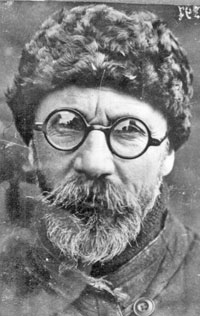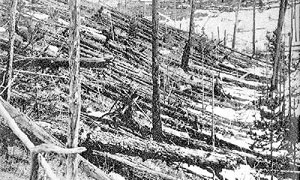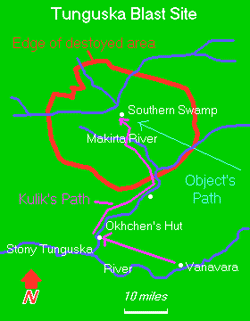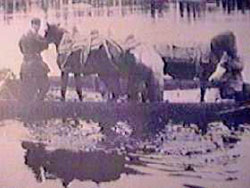|

by Lee Krystek
1997
from
VirtualExplorationSociety Website
 He
braved the isolated swamps and rivers of Central Asia to expose one
of the greatest mysteries of the 20th Century... He
braved the isolated swamps and rivers of Central Asia to expose one
of the greatest mysteries of the 20th Century...
"The results of even a cursory
examination exceeded all the tales of eyewitnesses and my
wildest expectations," wrote Leonid Kulik, remembering his first
glimpse of the Tunguska destruction.
He stood on the bank of the Makirta River at the end of an exhausting journey.
As far as he
could see upstream and downstream, the riverbank was littered
with the trunks of trees uprooted and pushed down in one
direction as if smashed by a giant’s hand. There was still snow
on the ground, and the dead and decaying branches and limbs were
outlined in stark relief.
Small hills stood out, he later wrote,
"picturesquely against the sky and taiga, their almost treeless
snow-capped tops stripped bare by the meteorite whirlwind of
1908."
Leonid A. Kulik was born in 1883 in the
city of Tartu in Estonia which was later to become part of the
Soviet Union.
He studied at the St. Petersburg Forestry Institute
and later in the Physics and Mathematics Department of Kazan
University. He served in the military during the Russo-Japanese War
and World War I. Between these two conflicts, he ran afoul of the
law and spent a short time in prison for revolutionary activities.
After World War I he taught mineralogy in the city of Tomsk and in
1920 took a position at the Mineralogical Museum in St. Petersburg
(later renamed Leningrad). At the Museum he devoted much of his time
to a new discipline: the acquisition and study of meteorites. In
1921 Kulik was charged with the task of locating and examining
meteorites that had fallen within the Soviet Union.
While preparing
for this expedition, he came across an account of an explosion in
Tunguska, Siberia, reprinted from an old newspaper:
...a huge meteorite is said to have
fallen in Tomsk several sagenes from the railway line near
Filimonovo junction and less then 11 versts from
Kansk.
Its fall
was accompanied by a frightful roar and a deafening crash, which
was heard more then 40 versts away. The passengers of a train
approaching the junction at the time were struck by the unusual
noise. The driver stopped the train and the passengers poured
out to examine the fallen object, but they were unable to study
the meteorite closely because it was red hot...
Strangely enough the story turned out to
be wrong in almost every detail, but even so, Kulik had never heard
of this impact before and it caused him to go searching for
additional old newspaper accounts.
By piecing these stories together
he determined that the event, which he felt sure was the result of a
meteorite fall, must have been enormous. Kulik decided to see if he
could find the site during his trip.
During his first expedition Kulik only managed to figure out the
general location of the blast area, not actually visit it. Afterward
Kulik continued to collect stories about the event.
Reports from the Site
 A
geologist sent this account which was told to him by a local
herdsman: A
geologist sent this account which was told to him by a local
herdsman:
"Fifteen years ago his brother, who
was a Tungus and could speak little Russian, lived on the
River Chamb’e. One day a terrible explosion occurred, the force of
which was so great that the forest was flattened for many versts
along both banks of the River Chamb’e.
His brother’s hut was
flattened to the ground, its roof was carried away by the wind,
and most of his reindeer fled in fright. The noise deafened his
brother and the shock caused him to suffer a long illness..."
Entnographer I. M. Suslov interviewed
the family who had been sleeping twenty-five miles southeast of the
blast site when the event occurred. The entire group was thrown down
by the force of the blast and several knocked unconscious.
The wife
reported that when they awoke they found
"...the forest blazing around them
with many fallen trees. There was also a great noise."
Some of the children described "A
terrible storm," Suslov continued, "So great it was difficult to
stand upright in it, [that] blew down the trees near their hut."
Despite resistance from some of his colleagues who questioned the
value of a trip based on rumors told by backwoods peasants, Kulik
used these and other reports to convince the Academy of Sciences to
fund a second expedition.
The 1927 Expedition
 The
1927 expedition had been planned for the spring. The
1927 expedition had been planned for the spring.
This would mean
they would reach the area before the ground in the region became a
swamp and the mosquitoes intolerable. Even taking these precautions
the journey was difficult going since Kulik was still not sure of
where the exact blast site was and the maps they were using were
inaccurate.
The first leg of their trip was accomplished by using the
Trans-Siberian railway. Kulik and a research assistant traveled from
Leningrad to the remote station of Taishet. From there they used
horse drawn sleds to make their way up the Angara River to
Keshma, a
small village where they purchased more supplies.
From that point on the way grew ever more difficult. The land became
more rugged. Deep gulches and steep hillsides blocked their path.
Their compasses became confused by the high latitude. It took until
the end of March to reach the tiny village of Vanavara located on
the Stony Tunguska River. Vanavara was the last outpost of
civilization before the expedition plunged into the primitive
forest-swamp where Kulik was sure the meteorite had fallen.
In the village Kulik hired a guide named Ilya Potapovich and started
interviewing locals about what they remembered about the blast.
He
found that many of the local people did not like to discuss the
event. They believed that the fiery body that had fallen was a
visitation of the god Ogdy. Ogdy had cursed the area by smashing
trees and killing the animals.
No man now approached the site for
fear of being cursed by the god.
This story only peaked Kulik’s interest and he soon set out on
horseback, with the guide, to find the fall. An unusually heavy snow
blocked their path, though, and they were forced to return to the
village and await better weather.
On April 18 the expedition set out again with pack horses. This time
they followed the course of the river. They took three days to reach
the hut of Okhchen, a friendly herdsman, located on the
Chamb’e
river. By that time both Kulik and his assistant were suffering from
infections and lack of proper food. Only the belief that their
destination was only a short distance away kept them going.
They left the horses at Okhchen’s home and loaded their supplies
onto reindeer for the last portion of the journey. After two days of
following the bank of the Chamb’e due north they came to the
Makirta
river and saw the first evidence of the Tunguska blast.
The already
exhausted party marched northward into the devastation, sometimes
having to hack their way through the dead entangled limbs and
branches of the fallen trees. As they traveled closer to the center
of the area Kulik noticed that the trees had been burned from above.
He was sure it was the work of a sudden flash of intense heat, not a
forest fire.
The scientist speculated that what the meteorite had,
"pushed ahead of it was doubtless a
giant bubble of superheated atmosphere, hotter than the blast of
any earthly furnace..."
Starting Over
They traveled for two more days through the destruction when
suddenly his guides, Potapovich and Okhchen, apparently fearful of
Ogdy’s punishment, refused to go forward. Kulik was forced to return
to Vanavara and hire new guides.
On April 30th, Kulik, with his
new helpers, set out again for the fall site. This time the
party, aware of the difficulty of marching through the
forest, built rafts to carry them along the Chamb’e and
Khushmo rivers toward their destination.

Using the river
to get to the site.
The water courses were swollen
with the spring melt and it was necessary to navigate
several rapids.
It had been three months since the expedition had left
Leningrad. No word had come back from Kulik, and his
colleagues began to fear the worst. Was the scientist lost
or dead in the uncharted Siberian wilderness? Or had he
simply not sent word back because he was embarrassed about
finding nothing?
Back in the field the expedition had
gone as far as they could by water and headed north on foot finally
reaching the ruined forest on May 20th. For a week they cut though
the tangle of dead tree limbs and marched toward the center of the
fallen wood.
Kulik finally set up camp near the mouth of the
Churgima River believing that the crater he sought must be just
beyond the next ridge in a marshy basin his guides referred to as
the Southern Swamp.
Impact Zone
From this camp Kulik made daily trips out across the dead
forest until he circled the entire area.
From his observations he
could see that on every side of the swamp the fallen trees lay with
their tops pointing outward. That meant that the center of the swamp
was the fall point of the meteorite for which he was searching.
Instead of finding a giant crater, though, Kulik saw a standing
forest of what looked like telephone poles. Each trunk stood
straight and tall, but charred and stripped of its branches.
In the very center of this forest Kulik found a peat marsh blasted
and tortured into a fantastic landscape.
"The solid ground," wrote
Kulik,
"heaved outward from the spot in giant waves, like waves in
water."
He also found dozens of "peculiar flat
holes" ranging in size from ten feet to fifty feet in diameter. Each
was several yards deep.
Kulik carefully documented and photographed the area and decided to
return on a later expedition and probe the holes with digging
equipment in an attempt to locate fragments of the meteorite he
thought might be beneath them.
Realizing that nothing more could be done on this trip and that the
group had only three or four days of food left, Kulik decided to
leave. It was a good decision.
The summer thaws soon made traveling
increasingly dangerous. The expedition set out and after nine days,
having supplemented their diet with ducks, fish and local plants,
they arrived back in Vanavara at the end of June.
Kulik returned to the Academy with enough photographs and
documentation to convince even his most skeptical colleagues that
something amazing had happened along the Tunguska river. He led two
more expeditions back to Siberia, one in 1929 and another in 1938,
but was never able to establish that the culprit in the blast was a
meteorite. Even today the exact cause of the explosion is unknown.
Kulik continued to work on the problem until, while fighting for his
country in World War II, he was captured and died of typhus in a
Nazi prison camp on April 24th, 1942.
The success of Kulik’s expedition wasn’t in solving the mystery of
the Siberian blast of 1908, but in proving to the world that objects
have, and continue, to fall from space and can have a devastating
result on Earth. T
his knowledge has led to a better understanding of
how these impact events effect life on our planet and how they might
explain such mysteries as the death of the dinosaurs.
|
 He
braved the isolated swamps and rivers of Central Asia to expose one
of the greatest mysteries of the 20th Century...
He
braved the isolated swamps and rivers of Central Asia to expose one
of the greatest mysteries of the 20th Century...  A
geologist sent this account which was told to him by a local
herdsman:
A
geologist sent this account which was told to him by a local
herdsman:  The
1927 expedition had been planned for the spring.
The
1927 expedition had been planned for the spring.
